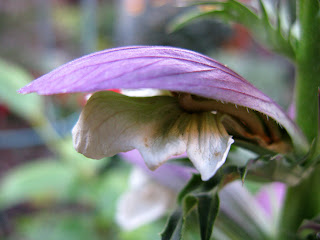Hello, here are the rest of the pictures from my garden that I took yesterday, there were just too many to put in yesterday’s post so I had to split them over two days. Yesterday I concentrated on the summer flowering Hellebore that is lighting up the end bed of my garden at the moment; today I have photos of a rather more peculiar plant – Acanthus spinosus.
I have written about this plant before this year, but it looks at its most impressive right now so I thought I should take some photos again and make a post dedicated to this spectacular plant. I have grown my plant from a seed I took from someone else’s plant in 2004, and I am quite chuffed that it is still alive and doing so well. I always feel more protective against the plants I raise myself, either from seeds or from cuttings, especially if it takes many years before they start flowering. I have for example around 150 lilies, most of them raised from seeds from the original 8 bulbs I got as a present. It takes on average 4 years before lily flowers when you raise it from seeds, and 8 years before it is fully mature. Patience, patience…
These photos show the whole plant with the impressive flower spikes, close-ups of the flowers, a seed and the last photo is of the crown seen from above. Click on each thumbnail photo to view a larger size, they look much more impressive in their original size!
And this is info I have picked from different web-sites: Acanthus is a genus of about 30 species of flowering plants in the family Acanthaceae, native to tropical and warm temperate regions, with the highest species diversity in the Mediterranean Basin and Asia. Common names include Acanthus and Bear's breeches. The generic name is derived from the Greek word acaanthos, meaning "thorny. Acanthus spinosus is commonly known as Bear's breeches. The plants make large, mound-shaped rosettes of glossy leathery leaves, finely cut and each tipped with a ferocious spine. The flower spikes resemble tall foxgloves from a distance, with hooded two-tone flowers, a fantastic, architectural plant that’s justifiably popular. It is deciduous, the deep green glossy leaves can be up to 90cm long, and the spectacular spikes of white flowers with purple hoods shoot up from the foliage and last for several weeks. It thrives best in dappled shade and although it will take full sun, the leaves may scorch.
When my plant gets a bit older I will take some of the side shoots and put in pots to have a few plants in reserve, this is something I do with most of my plants, just in case something happens with the mother plant. You never know what can happen to plants, especially during extreme winter weather, or extreme summer weather for that matter – can be just as devastating…a hailstorm in June for example….pretty damaging stuff! Not that I think the Acanthus will perish due to a hailstorm, I think it possibly would take an earthquake and a following tsunami in terms of natural catastrophes to eradicate the whole plant including the roots! No, this plant is more susceptible to suffer with lack of water over a long time, which means it won’t flower well, or the stalk will dry out and not look nice. But in any case, it’s great to have a few in reserve, just make sure to give the cuttings a place in the garden or a large tub after a year or two as they have very big roots that doesn’t like being squashed in a small pot for very long.
That was it for tonight, I got more photos from yesterday but I think this post looks good with just the Acanthus photos so I’ll save them for next time :-) See you soon!
That was it for tonight, I got more photos from yesterday but I think this post looks good with just the Acanthus photos so I’ll save them for next time :-) See you soon!










No comments:
Post a Comment
Note: only a member of this blog may post a comment.